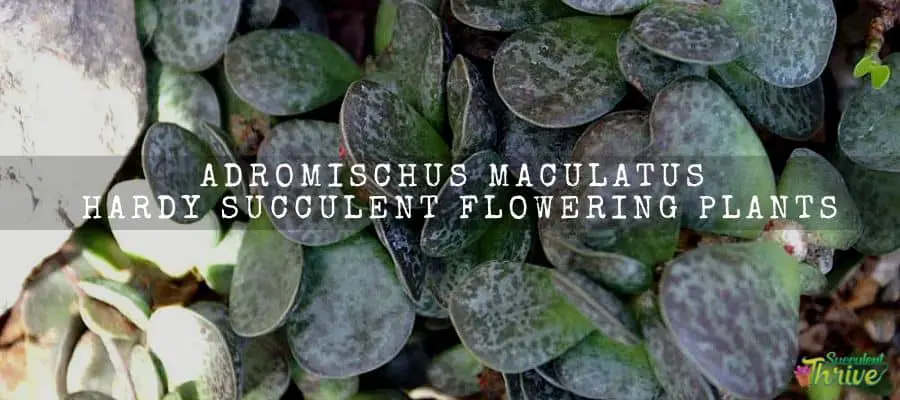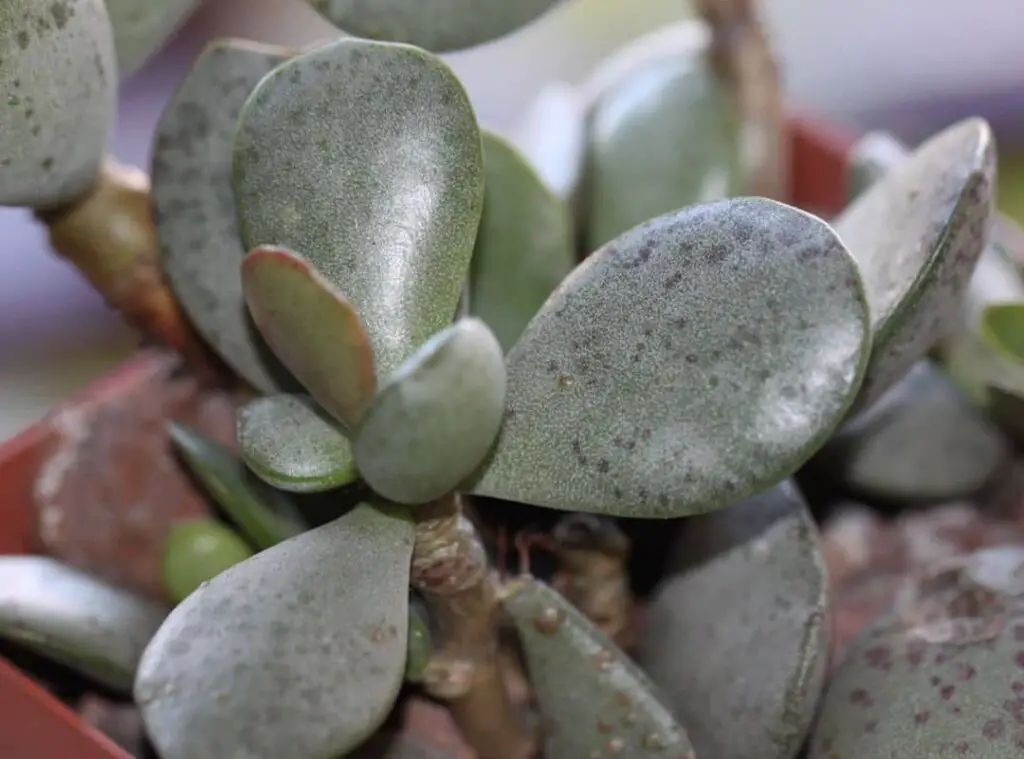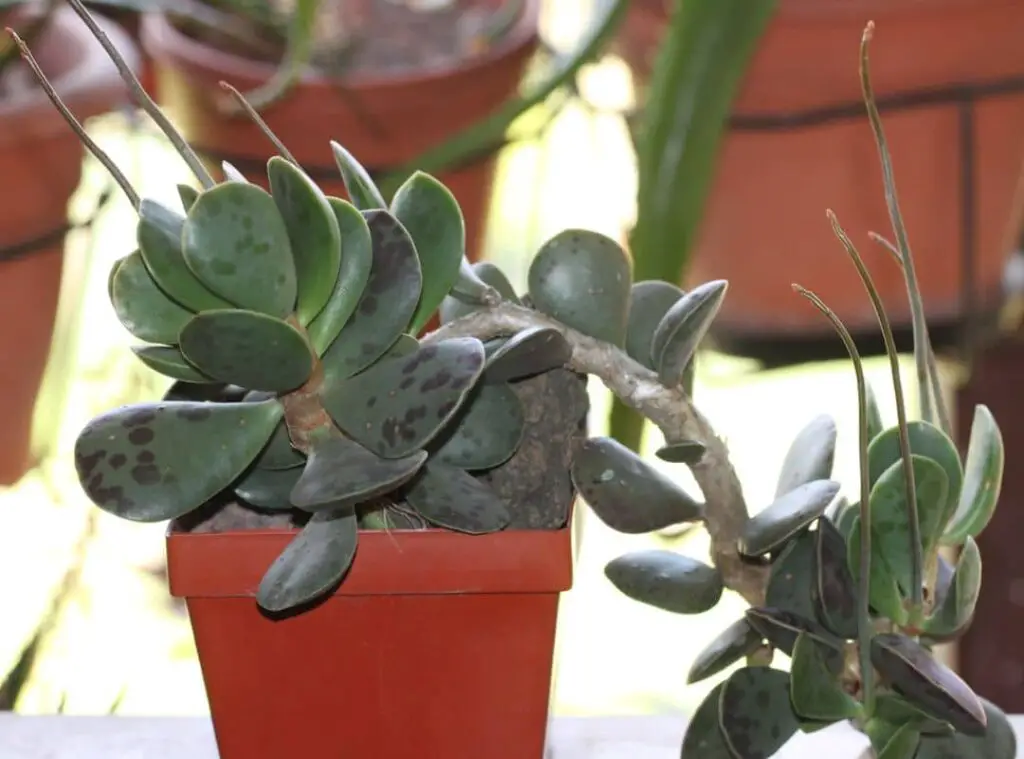Adromischus maculatus are a favorite pick of all the succulent lovers and it is quite a famous and a trendy plant. If you are new to these plants , this article will make you want to have one.
Adromischus maculatus are appealing in their looks. Furthermore, their appearance is unique as well. They are a must have succulent in anybody’s garden as they would intensify the beauty of the garden.

Cultivating the Adromischus maculatus and taking care of them is very easy. Adromischus maculatus are known as Calico hearts in common.
Further they also go by the common names called chocolate drop and spotted Adromischus as well. Adromischus maculatus are hailing from south Africa.
The scientific name Adromischus literally refers to the thick stems. Further maculatus literally means spotted. Adromischus maculatus are fragile plants and you need to refrain from touching the plants quite often.
In addition to that, Adromischus maculatus comprise a shallow root system and that characteristic makes them prone towards root rot. These plants usually grow in semi-arid climates when they grow in the wild.
As such, you need to mimic the same conditions when you cultivate them as well. So, let’s get into it !
How do I identify Adromischus maculatus?
Adromischus maculatus are tiny plants which would form either in clusters or in mats. Their stems are short and woody.
In terms of the sizes, Adromischus maculatus are as tall as 8 inches. Moreover they are about 8 inches in width when they are fully mature.
Adromischus maculatus stems would usually lie somewhat closer to the ground without growing in an upward manner like the other regular plants.
If I explain on the Adromischus maculatus leaves, they will tend to take either a round or a wedge shape. Leaves would be about 3 inches long and 1.5 inches broad.
Adromischus maculatus leaves would contain a horny leaf margin too. Those leaves would usually form in grayish green or grayish brown color.
Once the plants mature, their leaves would carry speckles in dark green in purple. However , once you expose them for ample sunlight it would make the spot color intensified. Usually, young Adromischus maculatus plants don’t come up with speckles and only the matured plants would.
Besides these features, Adromischus maculatus would produce flowers in white. Moreover those flowers would be tubular in shape.
Further they may come up with a green inflorescence too. Occasionally you could spot those flowers forming with pink tinges too.
Size of the plant
Adromischus maculatus would attain a maximum height of 8 inches ( 20cm) when they are fully mature. Further they would be the same size in diameter too.
Growth rate
Adromischus maculatus grows at a very slow rate.

One look care guide
| Botanical Name | Adromischus maculatus |
| Common Name | Calico hearts |
| Plant Type | Succulent |
| Mature Size | 8 inches in both height and in width |
| Sun Exposure | Full sunlight to partial shade |
| Soil Type | Well draining |
| Soil pH | Acid, Alkaline Neutral, |
| Bloom Time | Spring and autumn |
| Flower Color | White |
| Hardiness Zones | Zone 9a (Minimum 20° F | -6.7° C) |
| Native Area | South Africa |
| Toxicity | Toxic |
| Average price | 7 USD |
How do you take care of the Adromischus maculatus?
If you are someone into succulent gardening for quite a long time, you can easily grow these plants as Adromischus maculatus would require pretty much the same growing requirements as the other succulents do.
They only need a minimum care treatment from you and all you need to assure is that they get optimal environmental conditions irrespective of the location you grow them.
Once you look after them well, they will strive well and keep adoring your entire set up for a longer period.
Light Requirement
Adromischus maculatus would ideally wish to have bright indirect sunlight. Having said that, they can also withstand full sunlight, light shade and partial shade too. However, you need to ideally grow these plants exposed to at least six hours of sunlight to assure a healthy growth in the plants.
So, if you want to grow them in the garden, ensure that chosen place is a brightly lit place. That said, the chosen place should be secured from scorching sunlight as well.
If you expose the plants to such adverse conditions, it would make the plants suffer from scorches. When you grow them indoors, you should locate them closer to a bright sunny window edge.
Temperature and humidity
Adromischus maculatus can grow fine in room temperatures. Having said that, they would not tolerate temperatures which dropped 50 degrees Fahrenheit ( 10 degrees Celsius).
The most appropriate temperature which would suit these plants the best would be around 66 degrees Fahrenheit – 86 degrees Fahrenheit ( 19-30 degrees Celsius).
Once the adverse winter conditions are predicted, you need to protect the plants by bringing them indoors if you have grown them outdoors. In fact, if the temperature gets dropped to 20 degrees Fahrenheit (-6.7 degrees Celsius) you could shift them indoors.
If you are experiencing extreme winter conditions, I suggest you plant them in containers and grow them indoors. Further when summer arrives. On another note, you should not locate them closer to heat vents, Air conditioners as they would not prefer to grow in high humidity levels. In other words, low humidity levels would be optimal for these plants’ healthy growth.
Is it cold hardy?
Adromischus maculatus are not frost hardy plants.
Growth Zone
Adromischus maculatus most favorite USDA hardiness zone is Zone 9a (Minimum 20° F | -6.7° C)
Watering Requirement
Adromischus maculatus‘ natural habitat would be semi-arid climates where they don’t get exposed to too much water. In fact, Adromischus maculatus are succulents which literally means their leaves can store water.
That helps them to thrive in drought conditions. As such you don’t need to water them frequently. When watering, you need to check whether the top layer of the soil is dry.
If you doubt whether it is dry or not, you should skip watering them for one or two days. Always let the soil wither between two watering sessions.
Keep in mind that it is always best to supply these plants with water moderately as they would be quite responsive towards over watering. If your Adromischus maculatus plants are growing in waterlogged soggy conditions, they may be subject to diseases such as root rot.
On the other hand, if these plants lack sufficient water, their leaves would turn brown . further they would end up getting dropped from the plants eventually.
In contrast to that, If your plants are overwatered, their leaves would be yellow in color and soft to the touch. Unfortunately, it is very unlikely you could save over watered plants as it would generate damage for the plants well being.
Watering the Adromischus maculatus plants precisely is a critical factor when providing the best growing conditions for them.
In simple words, you need to water these plants thoroughly and allow them to wither after that. You may water them more often during spring to fall. You could limit watering the plants to once every three weeks during winter whenever their soil is dry.

Soil Requirement Type / pH.
If you are wondering what kind of a soil mix would be more appropriate for these plants, you need to go ahead with a substrate which has a high porosity and a fast draining facility.
Other than these two requirements, Adromischus maculatus don’t have any other higher demand when it comes to selecting the right soil mix.
You may choose a commercially made succulent potting mix to grow these plants as those are perfectly fit in for them. However if you desire to further increase the draining, you can consider adding a layer of perlite.
Pot size Potting and Repotting
Adromischus maculatus are slow growing plants which literally means you can allow them to thrive in the same pot for a number of years.
That said, if you could spot a significant growth in the plants, best would be to repot the plants in a slightly bigger pot.
All you need to do is just fill the pot with an appropriate soil mix and plant them after that. Further, you need to always look for pots which have ample drainage to grow them.
Where to Plant
Adromischus maculatus are not frost hardy plants. As such, if you live in any area where the temperature drops below 20 degrees Fahrenheit ( -6.7 degrees Celsius) , you need to consider growing them in planters and placing them indoors.
Once the weather conditions get better, you may bring them outdoors. In addition to that, you need to choose a spot where the Adromischus maculatus plants can gain sufficient sunlight as well.
Fertilizer and time of year
Adromischus maculatus have minimal requirements when it comes to fertilizing. So, you do not need to bother in supplying any extra nutrients for the plants.
In fact, you don’t need to provide any organic matter for them when you cultivate them outdoors. However, if you have potted them, a little feeding would be beneficial on them during their active growing season.
Once you feed them, you need to always refer to the labeled instructions . Furthermore you should feed the plants only if their soil is moist.
Flower
Adromischus maculatus would come up with white flowers during spring and in autumn. Further they would be tubular shaped as well.
If I further elaborate they would come up with a green inflorescence too. Further you may spot them producing pink tinges once you expose them for ample sunlight.
Dormancy
Adromischus maculatus are Summer dormant plants.
Toxicity
Unfortunately Adromischus maculatus plants could be toxic for both pets and for humans as well.
Common bugs and illnesses
Chances are that Adromischus maculatus may have to encounter invaders occasionally too. This is a common occurrence particularly if there are appealing conditions for these pests.
However among all these pests, the most troublesome pests types would be mealybugs and vine weevils. So when you look after these plants, you should closely watch out for any early signs of pests infestation.
If you ever come across any, you need to rectify that issue at that time itself. That way you can avoid any further adverse weather conditions. Best would be to treat them with a fungicide.
Adromichus maculatus benefits
Adromischus maculatus would be excellent for both indoor and outdoor gardening. Moreover, you could share these plants as great gift items among your friends too.

How to propagate Adromischus maculatus.
Propagating Adromischus maculatus is somewhat tricky. However let’s get into how you could propagate the Adromischus maculatus !
Propagate using the offsets?
In fact using the offsets propagation method is the easiest way of propagating the Adromischus maculatus. This plants are low growing plants which would usually develop clumps of offsets.
You may simply separate them and transplant them in individual pots. When removing the offsets, you can simply cut them with sharp, sterile tools.
Ensure that you remove the older soil around the roots of them next. You need to be very careful when handling this as their leaves would tend to drop easily even if you try to touch them delicately.
Next , dry them for one or two days as then it will make them become calloused. Next you can transplant them into a new pot and treat them like you regularly do for a mature plant.
Propagate using the cuttings ?
Using the stem cutting method to propagate the Adromischus maculatus would be somewhat complicated. However, many people tend to use this method as this has a higher rate of success.
There are some who wish to use the leaf cutting method but it would be less successful when you compare them with the stem cutting propagation method.
Just like in the offsets method, you need to make use of sterile sharp tools and remove the stem cuttings from the plants.
After that leave the cuttings in a well aerated dry warm place to develop callus on their cut ends. When you use callused cuttings, it would help you to avoid any occurrence of fungal and bacterial infections.
In addition to that you may also consider dipping the cut ends in a rooting hormone as then it would speed up the rooting process of the cuttings. They would usually start to develop roots within a few weeks’ time.
Propagate using the seeds ?
If you are a patient gardener, you could consider using the seeds propagation method to propagate the Adromischus maculatus plants.
However, it would not be as successful as the other methods mentioned above. Further it would take a longer time to showcase the results of this method too.
You may obtain the seeds either online or obtain them from your plants. Next you need to soak the seeds for about 12 hours or for 24 hours. It would stimulate the germination of the seeds. After that you can sow the seeds in a pre moistened soil mix.
I suggest you cover the seeds until they start sprouting as it would allow them to conserve humidity then. However ensure that it doesn’t make the specimen too humid as then it would result in root rot.
Once you spot the seedlings appearing in the specimen, you can remove the cover and treat them the way you treat a regular plant. You need to wait until the seedlings grow somewhat larger and then pot them in individual pots.
Conclusion
Adromischus maculatus is a very special plant as they don’t have any specific demand in terms of the care treatments. They would grab anybody’s attention due to the unique foliage they inherit.
Just like taking care of them, propagating them is also very easy. So, I hope now you are all excited to start growing these beauties !
Read Next : Adromischus Marianiae Tanqua : A Living Gift
